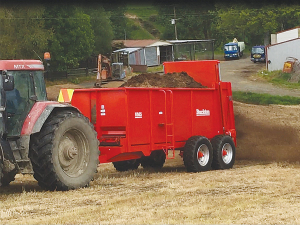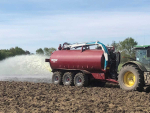The MS muck spreader range does what it's supposed to do.
The Buckton website dates the company back to 1963, but it can be traced back to 1950 when Victor Buckton went into business refurbishing old trucks for farming.
Sons Eric and Morris joined in the early 1960s and they made a range of farm equipment that developed a good reputation at home and in Australia, Chile, the US and South Africa.
Now the brand sits under the umbrella of Giltrap Engineering, still a broad, durable range for pastoral farmers and contractors.
The MS muck spreader range is a case in point. It may not win a prize for good looks, but the machines appear well put together and capable of doing what the maker claims.
There are four models with nominal capacities of 9, 12, 15 and 20cu.m. At their heart is a chassis made from high-grade RHS, hot rolled for strength — a method used for truck frames.
Heavy-duty oscillating tandem axles have replaceable pivot bushes for extended life, while the body — in effect a semi-sealed bin — uses heavy section, close-spaced steel vertical bracing for rigidity and to deal with heavy loads.
At each end of the body, heavy-duty rubber base seals allow the units to hold semi-liquid manures plus typical solid materials, and a clear front panel gives operators a view of the load.
The drive line has a 1000rpm input (with shear bolt protection) that is transferred to the rear of machine where the drive is split to twin vertical discharge beaters.
The floor drive is controlled hydraulically, allowing precise speed control to alter application rates when used with the hydraulically operated rear door.
Attention to detail sees the floor conveyor chains recessed into the floor of the body, a detail that reduces loads on the chains and drive sprockets and ensures the body is emptied cleanly. Four bed chains carry welded conveyor slats running in pairs with split drives to reduce peak loadings.
Maintenance on the bed is by heavy-duty spring-loaded chain adjusters to keep tracking true; sight glasses are fitted to gearbox drives and grease nipples are fitted at appropriate points.
In operation, spreading width and application rates are influenced by several factors, including the type of material, floor conveyor speed, rear guillotine door position and rotation speed of the rear beaters.
Spreading width is typically 10 to 20m, dependent on the material being applied.
Standard equipment includes a braking system fitted to the front axle, and tyre equipment depends on the model -- 22.5-inch diameter flotation units ranging from 400/70 to 550/60 sections.
Optional equipment includes LED lighting kits, a quick-hitch skid and hydraulic parking jacks.


















